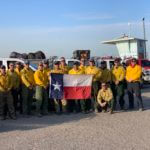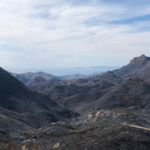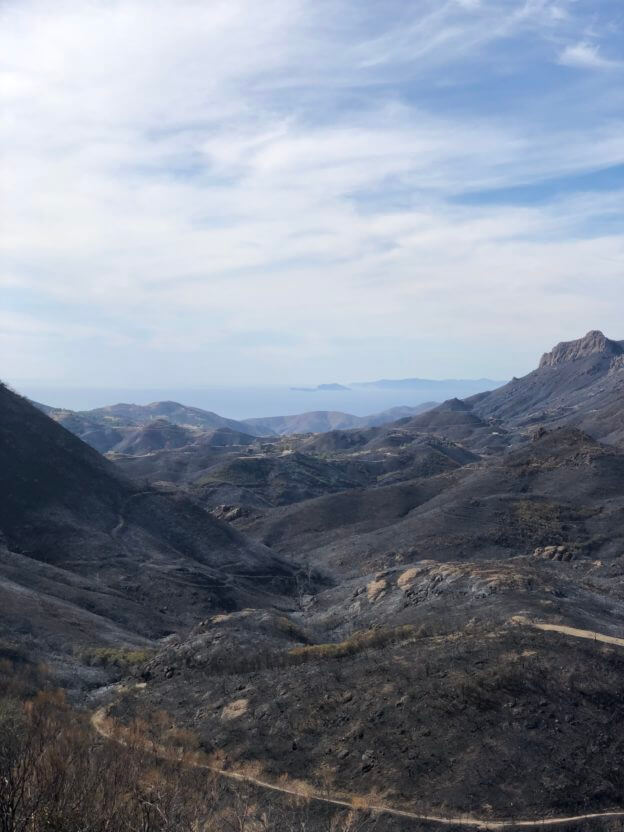
LTFR firefighters, Lt. Adam Griggs, battalion chief Eric Carlson, Lt. Travis Mc Anally were all part of the Texas team that joined the 3,600 people assisting with the California fires.
By LYNETTE HAALAND, Four Points News
Local Lake Travis Fire Rescue firefighters helped fight the Woolsey Fire in southern California a few weeks ago. The fire started Nov. 8 and was 100 percent contained by Nov. 21 after burning nearly 97,000 acres, killing three people and destroying more than 1,600 buildings in Los Angeles and Ventura counties.
Three LTFR firefighters — who typically work to protect Steiner Ranch, Comanche Trail, Strawberry Hill, Monteview Acres and other Four Points areas — were among some 200 firefighters from across Texas who traveled to California in November to help work the enormous fire.
“I’ve seen some large fires, big areas acre-wise but knowing how fast the fire went with the Santa Ana winds and how much ground it covered, just the devastation that it left,” said Lt. Adam Griggs, LTFR inspector/investigator of the wildland fuels mitigation fire prevention division.
“Knowing that an ocean stopped the fire from its westward shift,” Griggs said shows how powerful it was. “It was very sobering how much had burned. It was as far as I could see.”
Eric Carlson, LTFR battalion chief and Travis Mc Anally, LTFR lieutenant, joined Griggs on the assignment that the Texas governor had to sign off on.
They were part of the Texas Intrastate Fire Mutual Aid System or TIFMAS program. They joined others from central Texas including Austin, Round Rock, Oak Hill, Kyle, San Marcos, Bryan and New Braunfels, and from other cities including Arlington, San Antonio, Lubbock and Amarillo.
The LTFR trio left for California on Nov. 12. They were part of a caravan of six fire department trucks with others also on the assignment. They took two days to get there.
“There were 50 plus (total vehicles) from the state,” Griggs said.
The Texas team was part of 3,600 people working on the fire and its aftermath.
When they arrived, they were organized according to expertise and specialized vehicles including structure engines and brush trucks.
Strike teams were created with about five vehicles plus 18 and 21 people. Griggs said their strike team was assigned a variation of patrol and mop up. There were more than 295,000 people evacuated from the area.
“We interacted with residents who were still around and took care of anything smoldering or on fire,” he said “It required us to drive roads in the hills and get out on foot and hike a little bit.”
When they mopped up the area, they would check for hot spots, making sure there was a fire break where the fire would not continue to creep over a particular area.
Several images stuck out in Griggs mind including power lines laying on the ground because the poles were completely gone.
They typically worked about an hours drive from where they stayed at “fire camp”.
“We could see the Pacific Ocean on most of the hilltops we were at,” Griggs said. “We worked between Hwy. 101 and the Pacific Coast Highway.”
Fire camp was set up at the airport in Camarillo, Calif. where there was a large area to park engines and brush trucks.
“It was dusty like all fire camps are,” Griggs said.
Fuel trucks would come into fire camp and deliver fuel to all of the vehicles being used.
“Having 3,600 people in a smaller community (like Camarillo) taxes its resources pretty quick. We can tap a gas station out with 50-plus trucks,” Griggs said.
The camp also consisted of multiple 18-wheeler trailers. Some trailers were kitchens where the catering staff served hot meals and made sack lunches. Other trailers were showers and places to clean up.
There was a camping area where firefighters pitched tents to sleep in. If they didn’t have a tent, they would check one out.
Griggs said TIFMAS is primarily used within Texas but the Woolsey Fire was the second time the program was used out of state this year.
“It’s a great program,” Griggs said. “We get to train and work with other guys around the state. We get to see different fires and fuel types than in Central Texas. It also gives us the opportunity to work with the (United States) Forest Service.”
Griggs found that it was a great learning experience to work with the different dynamics of the different crews.
They also worked near inmate crews they were not allowed to talk to, because of state law, or hand anything to, which is federal law.
“We observed inmate hand crews fight the fire and cut line with hand tools,” he said.
The crew returned home on Nov. 21.
LTFR staff working behind the scenes gave the three local firefighters the opportunity.
“The opportunity to go out to California was made possible by our fire department. Those you don’t see in the pictures,” Griggs said. “They allowed us to go out there and give a helping hand.”
“Everyone has a part and every little bit matters,” Griggs said. “Being on an incident of that size is humbling.”

Nearly 97,00 acres of land were burnt before being contained, a process that took fourteen days and over 3,600 people.

